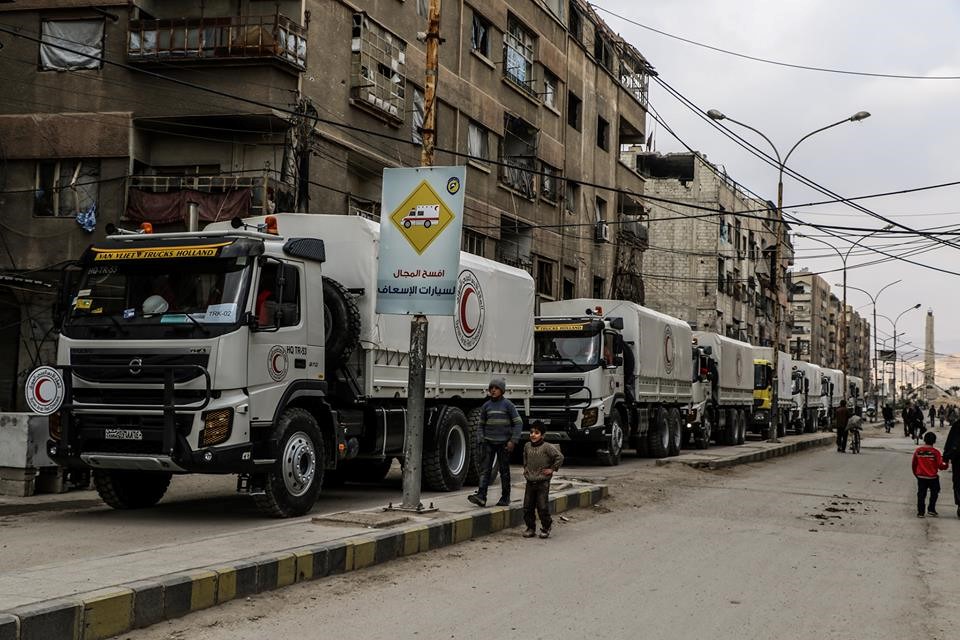Update: In the 5th of March 2018 Syrian government officials removed trauma kits and surgical supplies from trucks that are part of an inter-agency convoy heading into the besieged Syrian enclave of eastern Ghouta, According to a World Health Organization (WHO) official who had this statement to Reuters: “All trauma (kits), surgical, dialysis sessions and insulin were rejected by security,” a WHO official said by email, adding that some 70 percent of the supplies loaded on its trucks leaving its warehouses had been removed during the inspection.
Preface:
About 400,000 people trapped[1] in Eastern Ghouta are suffering catastrophic humanitarian conditions due to the lack of humanitarian and UN assistance provided to them, besides the tight siege imposed by the Syrian regular forces for more than four years ago, which barred the entry of any food or medical supplies into Eastern Ghouta.
According to the field researcher of Syrians for Truth and Justice/STJ, the humanitarian situation has worsened throughout Eastern Ghouta, following the recent military campaign[2] launched by the Syrian regular forces on February 18, 2018. Following which a total blockade was imposed on civilians, especially after all crossings into Eastern Ghouta, such as the "Al-Wafddien Camp crossing", which is located near Adra town and held by pro-government forces. This crossing was sometimes used for the entry of some foodstuffs into al-Ghouta after paying high taxation on them imposed by the Syrian regular forces.
STJ has recently issued a report entitled (As if It’s Doomsday!) in which it summarized the recent frequent events in the cities and towns of Eastern Ghouta.
For his part, STJ field researcher stressed that the situation of thousands of civilians in the besieged Eastern Ghouta is catastrophic, especially in the light of the crazy high food prices and the unavailability of any employment opportunities within Eastern Ghouta, which is totally isolated from the outside world because of the siege, and the inability of many humanitarian and relief organizations to be active there. Noting that this suffering has increased following the onset of the latest military campaign by Syrian regular forces on Eastern Ghouta on February 18, 2018, which was followed by the complete closing of all the crossings into Eastern Ghouta, such as the " Al-Wafddien Camp crossing" under the control of the Syrian regular forces, through which some foodstuffs have sometimes entered Ghouta, after the Syrian regular forces imposed high fiscal taxes on them.
The UN Security Council adopted Resolution No. (2401) amid a welcome from the United Nations, which called for a ceasefire throughout Syria for at least 30 consecutive days to enable the delivery of humanitarian aid and medical evacuation services of the critically sick and wounded.
António Guterres, the Secretary-General of the UN, has welcomed the Council’s adoption of the Resolution No. (2401), and expected the decision to be implemented immediately and permanently.
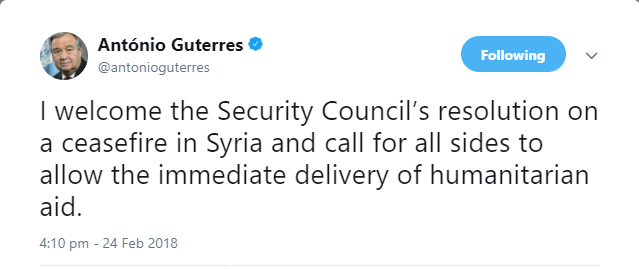
The United Nations Office for the Coordination of Humanitarian Affairs (OCHA) has described the situation in Syria as "bleak" in the wake of the UN Security Council resolution calling for 30-day ceasefire throughout the country.
For its part, the International Committee of the Red Cross (ICRC) said on February 26, 2018, that Eastern Ghouta is in urgent need to the entry of ICRC, indicating that it was not yet able to enter.
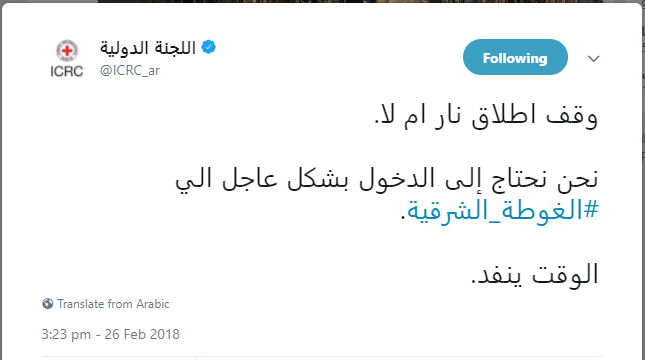
According to many testimonies obtained by STJ the UN aid convoy, which entered Eastern Ghouta for the first time since the beginning of 2018, specifically into Al Nashabiyah[3] district on February 14, 2018, was very few to the 40, 000 population of the area. The aid assistance was sufficient for only 7,200 people, including 1440 meals[4], along with some medical stuffs. According to multiple sources, this assistance has not been distributed yet (as of the date of this report, February 27, 2018), owing to the severity of the recent military campaign against Eastern Ghouta.
On November 12, 2017, another UN aid convoy entered the city of Duma, which covered medical and food stuffs, containing 4300-food basket. However aid recipients were (21500) person in Duma, knowing that the city's population is more than 150 thousand, which required the distribution of a single meal, estimated to weigh 55 kilograms of food, on more than five families. Shelling the local council warehouses by Syrian regular forces where the aid stored, specifically on November 15, 2017, led to the deprivation of many civilians trapped from assistance, according to an earlier report prepared by STJ.
First: Few Humanitarian Assistance that does not Meet the Needs of those Suffering:
On February 14, 2018, a UN aid convoy entered Al Nashabiyah town in Eastern Ghouta, consisting of nine trucks, two of which carried medical stuff, and the rest carried food stuffs, including (1440) meal, weight of each (60) kg approx, which was confirmed by Nizar al-Masouti, an activist from Al Nashabiyah town, where he spoke to STJ, saying:
"Before the entry of this aid convoy another one had already entered Al Nashabiyah town on November 28, 2017, when we began to coordinate with the United Nations in an effort to allow the entry of another convoy. Thereupon, a large delegation entered the town including doctors who checked the medical condition in the town and monitored many cases of malnutrition among people. These cases have been examined and evaluated by the delegation.
The UN delivers aid equally into five areas, in Eastern Ghouta, (Duma, Kafr Batna, Al Nashabiyah, Irbin and Harasta), without regard to the presence of very large numbers of displaced persons from outside Eastern Ghouta, such as Damascus city or other provinces."
Al-Masouti said that the premises on which the UN based on in bringing humanitarian aid to Eastern Ghouta are unknown. And he added that on February 14, 2018, the Syrian Arab Red Crescent announced the delivery of aid to 7,200 people in Al Nashabiyah. In this regard, he continued:
"The reality is quite different, that according to the latest statistic of December 17, 2017, the population of Al Nashabiyah town is about 40,000 people, approximately (10284) family, means that the de facto population is five times more than the number of people who the Syrian Arab Red Crescent said that it delivered assistance to. That caused a large gap between the income of the assistance and its adequacy for the civilian population in Al Nashabiyah."
Al-Masouti continued that, given the severity of the recent military campaign on Eastern Ghouta by the Syrian regular forces on February 18, 2018, the assistance that had recently entered Al Nashabiyah town had not yet been distributed. Explaining that the previous convoy that had already entered on November 28, 2017, included (1440) meal, and the one meal, which consists of 55 kg of food, was divided on several families, knowing that the one meal is enough to feed a family for only one week, which has increased the tragedy of many of civilians trapped in that area. It is worth mentioning that these convoys cannot enter Eastern Ghouta, without the permission of the Syrian regular forces, who give them it under political pressure or to achieve certain gains.
Video footage published by the Damascus Media Centre showed the first moments of the humanitarian assistance convoy’s entry to Eastern Ghouta, for the first time in 2018.
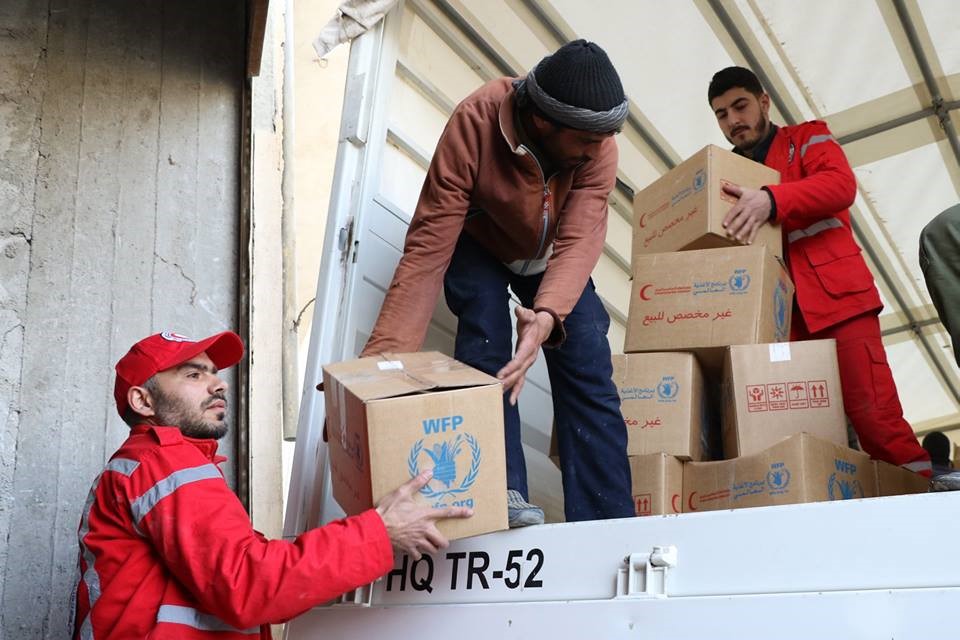
An image shows a side of the humanitarian aid that entered Al Nashabiyah town on February 14, 2018.
Photo credit: Syrian Arab Red Crescent.
Al Nashabiyah is one of the most impoverished areas in Eastern Ghouta, people there suffer from extremely poor living conditions, that’s was confirmed by Hasan Abdel Munem, a resident of Al Nashabiyah, and a breadwinner for a four-member-family, where he said:
"The aid that has recently entered my town is woefully inadequate, where I have received about (10) kg of food, which it may be enough to feed my family for one week at most, means that we will spend the rest of the days hungry, and that we're going to eat crumbs to help my starving children stay alive. The Syrian Regime used to impose very high taxation on foodstuffs, that traders were allowed to bring into Eastern Ghouta. As the price of a one kilo of sugar in Damascus is half a dollar, while in Eastern Ghouta it is priced at least (5) dollars, as the regime took a tax estimated to (2000) Syrian pounds, for every kilogram of food that enters Eastern Ghouta, plus its basic price of course. That prevented us from buying these food commodities due to their expensive prices. "
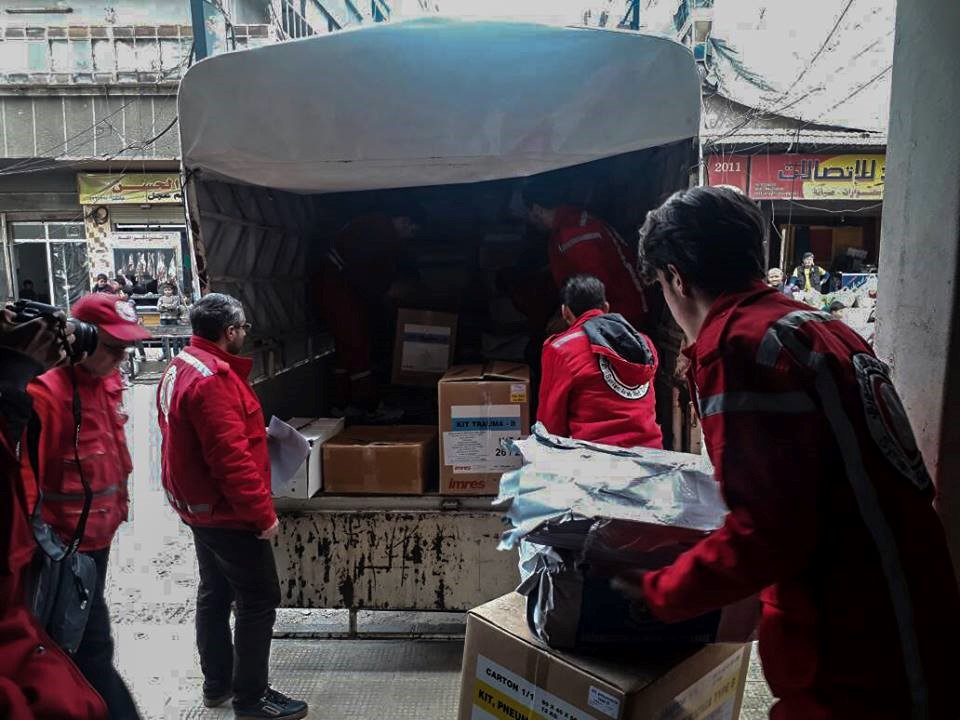
An image shows a side of the humanitarian assistance that entered Al Nashabiyah town on February 14, 2018.
Photo credit: Syrian Arab Red Crescent.
Second: Scarce Humanitarian Aid in Duma and the Damage of a Portion of it by the Syrian Regular Forces Shelling:
Earlier in 2017, on November 12, 2017, another aid convoy entered the city of Duma, which suffers like other towns and cities Eastern Ghouta from the siege imposed on it several years ago, this convoy consisted of 22 trucks, including 10 trucks loaded with foodstuffs, and nine others loaded with medicines. The number of food baskets was (4300), the weight of each (55) kg. Zaid Mohiuddin, one of the persons responsible for coordinating the entry of the convoys into the Eastern Ghouta, confirmed that by saying:
“The UN was supposed to rely on several reports compiled by observers present in the Eastern Ghouta for assistance distribution, but it did not did so, and has not yet established any clear criteria for the entry and distribution of aid, although we are always raising these reports and periodically update them, and then send them to international organizations, but unfortunately these reports were not considered once.”
The UN assistance has reached only 21500 people in the city of Duma, despite the fact that the city has a population of more than 150 thousands, and in this regard, he continued:
"The local council of Duma city was supposed to distribute every one meal, weighing 55 kilograms, equally on one family members, but unfortunately, the one meal has been distributed to more than five families. If we make simple calculations, we will clearly find that the entered assistance is inadequate for population. For example, the UN has entered (4300) food basket to Duma, each weighing (55) kg approx, equivalent to (236) tons. If we come to distribute this quantity of food on the number of people assisted, who are (21500), the result will be (10.9) kg per person. And if we come to distribute the total quantity of foodstuffs, (236000) kilograms, on the actual population of Duma, (150) thousand civilians, the result will be 1.57 kg, per person, which it may be enough to feed him for two days at most.”
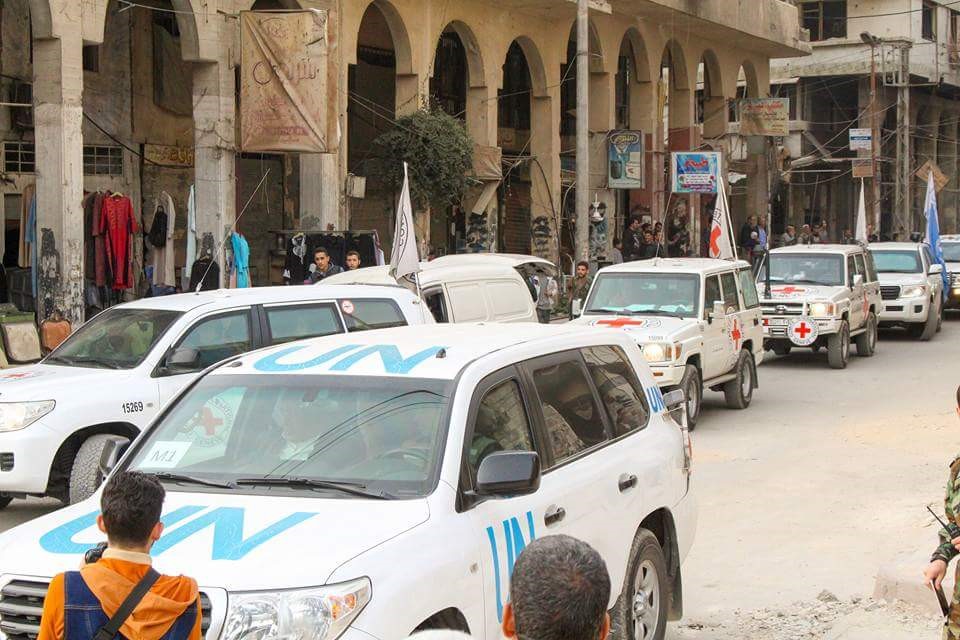
An image shows the entry of the UN covoy to Duma city on November 12, 2017
Photo credit: The Facebook page of Duma’s Local Council.
Despite the scarcity of humanitarian aid UN brought to the city of Duma, the local council distributed the food basket to the distribution centres located in the neighbourhoods of the city, but the intensive shelling by the Syrian regular forces on Eastern Ghouta cities and towns impeded the completion of this distribution, where one third of the food basket remained in the local council’s warehouses pending the possibility of resuming work.
On Wednesday, November 15, 2017, the military aircraft of the Syrian regular forces and their allies bombed the warehouse of local council, according to a previous report prepared by STJ, the shelling has damaged 40 meal in addition to 50 others which were affected by shelling distribution centres in Duma in the same day.
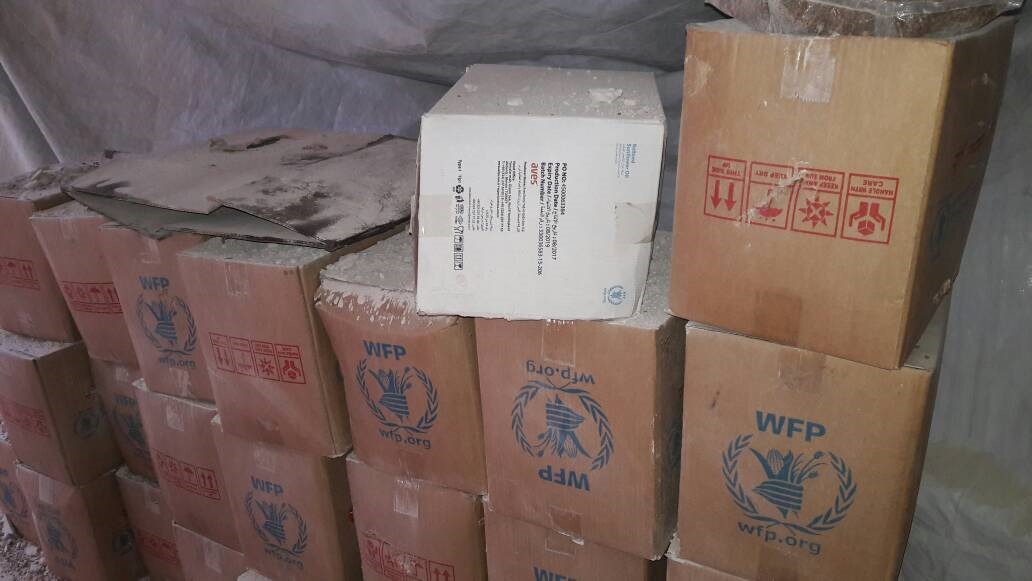
Image shows the damage caused to UN aid, stored in a warehouse of Duma's Local Council, being shelled by the Syrian regular forces and its allies on November 15, 2017
Photo credit: STJ
[1] STJ has relied on multiple sources, including UN, to determining the number of those trapped, which is estimated of about 400 thousand, as the UN used to state that the population of Eastern Ghouta is more than 390,000, and that was confirmed by other sources from inside Eastern Ghouta.
[2] On February 17, 2018, pro-government forces and militias mobilized a very large number of vehicles and soldiers on several points adjacent to Eastern Ghouta, according to military sources, these crowds were a part of preparations for the military operations in which “Tiger Forces”, affiliated to "Suheil al-Hassan” nicknamed The Tiger, al-Nimr, are involved, to control Eastern Ghouta region. This campaign has begun with intense bombardment, by warplanes, helicopters and heavy artillery, leaving more than 500 civilian deaths, from the day it begins to the date of preparation of this report according to multiple sources. That led several states to call for a ceasefire through the Security Council on February 24, 2018, which in turn issued Resolution No. (2401), calling for the cessation of hostilities throughout Syria for at least 30 consecutive days to enable the delivery of humanitarian aid. However, the Syrian regular forces launched a ground attack on the cities and towns of al-Ghouta from several directions which are (Harasta, Hawash al-Dawahira, Zuraiqia and Hazrama) in the morning of the day after the truce was signed, shelling populated areas which resulted in many civilian casualties, according to STJ field researchers.
[3] Al Nashabiyah district includes several areas such as Al Nashabiyah town, Bala, al-Marj, and al-Qantara.
[4] Each meal contains basic foodstuffs such as flour, rice, salt, beans, sugar, red / black lentils, broccoli, etc. Each of these items comes in the form of sacks, which then emptied into boxes, each weighs between 55 and 60 kg. After that, relevant institutions in Eastern Ghouta divide the single meal into a number of meals for the aid to cover the need of the largest number of families.

